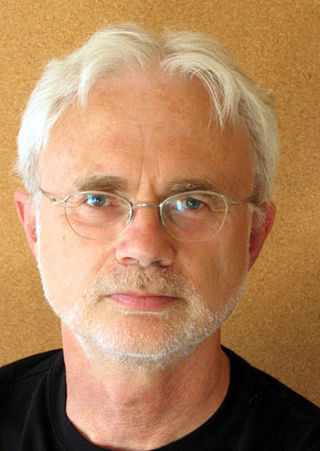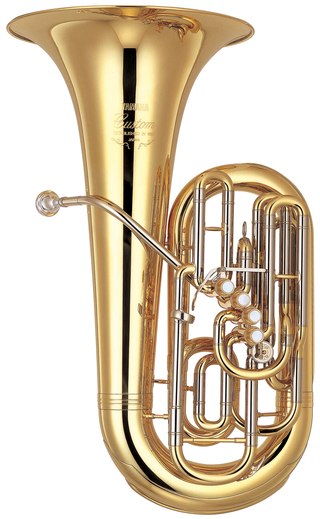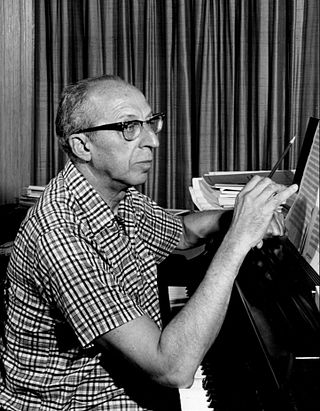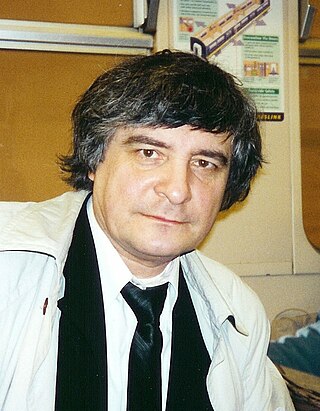
John Coolidge Adams is an American composer and conductor. Among the most regularly performed composers of contemporary classical music, he is particularly noted for his operas, many of which center around historical events. Apart from opera, his oeuvre includes orchestral, concertante, vocal, choral, chamber, electroacoustic, and piano music.

An orchestra is a large instrumental ensemble typical of classical music, which combines instruments from different families. There are typically four main sections of instruments:

The tuba is the largest and lowest-pitched musical instrument in the brass family. As with all brass instruments, the sound is produced by lip vibration – a buzz – into a mouthpiece. It first appeared in the mid-19th century, making it one of the newer instruments in the modern orchestra and concert band, and largely replaced the ophicleide. Tuba is Latin for "trumpet".
Harmonielehre is a 40-minute orchestral composition by the American composer John Adams, composed in 1985. In his memoir, Adams wrote that the piece "was a statement of belief in the power of tonality at a time when I was uncertain about its future" and that it was "a one-of-kind [sic] once-only essay in the wedding of fin-de-siècle chromatic harmony with the rhythmic and formal procedures of Minimalism".
Paul Seiko Chihara is an American composer.
The Concerto for Piano and Wind Instruments was written by Igor Stravinsky in Paris in 1923–24. This work was revised in 1950.

Grand traité d’instrumentation et d’orchestration modernes, abbreviated in English as the Treatise on Instrumentation is a technical study of Western musical instruments written by Hector Berlioz. It was first published in 1844 after being serialised in many parts prior to this date and had a chapter added by Berlioz on conducting in 1855.
Variations for Winds, Strings and Keyboards is an orchestral piece composed in 1979 by Steve Reich. The piece is scored for oboes, flutes, full brass, strings, pianos, and electric organs. Variations was Reich's first orchestral piece.
Ḥalil is a work for flute and chamber orchestra composed by Leonard Bernstein in 1981. The work is named after the halil, an ancient Jewish wind instrument. The work is sixteen minutes in length. Bernstein composed Ḥalil in honor of a young Israeli flutist Yadin Tanenbaum who was killed at the Suez Canal during the 1973 Yom Kippur war. The work was premiered at the Sultan's Pool in Jerusalem on May 27, 1981 with Jean-Pierre Rampal as the soloist and Bernstein conducting the Israel Philharmonic. The American premiere took place at Tanglewood on July 4, 1981 with Doriot Anthony Dwyer as the soloist and members of the Boston Symphony Orchestra.
The Concerto Fantasy for Two Timpanists and Orchestra is a double timpani concerto written by Philip Glass in 2000. It is paired with the Cello Concerto on Vol. I of Glass' Concerto Project, a set of eight concerti by the composer. A typical performance of the work lasts 25–28 minutes. It was written for Jonathan Haas and later recorded by Evelyn Glennie, and was premiered by Haas and Svet Stoyanov with the American Symphony Orchestra in Avery Fisher Hall, Lincoln Center, conducted by Leon Botstein. The work was commissioned jointly by the American Symphony Orchestra, the Peabody Symphony, the Milwaukee Symphony, the St. Louis Symphony and the Phoenix Symphony. In 2004, a transcription for wind ensemble was written by Mark Lortz, which debuted at Peabody Institute in 2005.
Peter Gregory Rose is a conductor, composer, arranger, and music director. He has conducted orchestral, choral and ensemble premieres throughout Europe and the Far East.
Color Music is a suite of five different compositions for orchestra by American composer Michael Torke. The suite is well known for its association with the composer's synesthesia.
Chamber Symphony is a 1992 composition for a 15-member chamber orchestra by American composer John Adams, inspired by Arnold Schoenberg's Chamber Symphony No. 1, Op. 9. It is a three-movement work that takes about 23 minutes to perform.
Soundings is an orchestral composition by the American composer Elliott Carter. The work was commissioned by the Chicago Symphony Orchestra for their final season with the conductor Daniel Barenboim as music director. It was first performed on October 6, 2005 at the Symphony Center, Chicago, by Barenboim and the Chicago Symphony Orchestra.
The Symphonia: sum fluxae pretium spei is an orchestral triptych by the American composer Elliott Carter. Its three movements were composed between 1993 and 1995. The complete work was first performed on April 25, 1998 at Bridgewater Hall, Manchester by the BBC Symphony Orchestra under the conductor Oliver Knussen. The second movement "Adagio tenebroso" was a finalist for the 1996 Pulitzer Prize for Music. The third movement "Allegro scorrevole" won The Prince Pierre of Monaco Music Composition Prize in 1998.
The Impostor is a concerto for Banjo and Orchestra written by Béla Fleck. Fleck premiered the concerto on September 22, 2011, with the Nashville Symphony in the Schermerhorn Symphony Center in Nashville. It was recorded over the course of three live performances and released on the eponymous album The Impostor. The concerto is dedicated to Earl Scruggs, who Fleck lists as his primary inspiration for playing the banjo.

Danzón cubano is a composition for two pianos by American composer Aaron Copland. The piece, written in 1942, was inspired by the Cuban genre of the same name. It was first arranged for orchestra in 1946.
Funeral Song, Op. 5, is an orchestral work by Igor Stravinsky. Composed in 1908 in memory of Nikolai Rimsky-Korsakov, the work received one performance in 1909. The work was then lost and not rediscovered until 2015.

The Triple Concerto No. 2, Op. 139, is a concerto for three instruments – violin, harp and double bass – and orchestra by Dmitri Smirnov, composed in 2003. It was premiered in the centenary concert of the London Symphony Orchestra on 26 May 2004, with principal players from the orchestra as soloists.